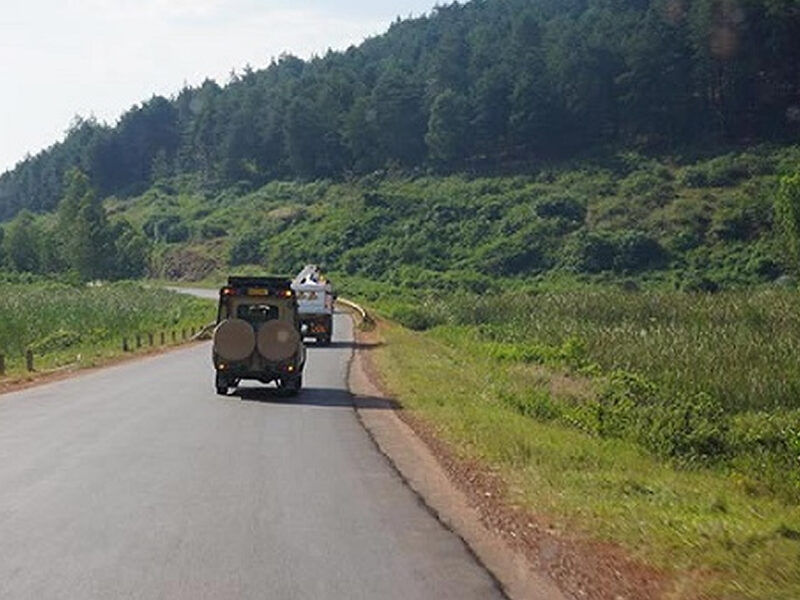
Tall Stories: Mvule (An unusual choice of Christmas tree this year?)
The Once Much Mightier Mvule – too popular for its own good?
In The Eye’s last issue, Cathy Watson gave lots of sound advice about how to grow Mvule. But there’s a lot of (natural) history behind why we should be planting it, upon which more light deserves to be shed.
Botany: Known more commonly across the world by its trade name ‘Iroko’, its botanical name is Milicia excelsa (previously Chlorophora excelsa), belonging to the Moraceae family – and is thus closely related to the Figs.
Ecology: A beautiful, tall tree that grows naturally across much of the lowland forests and wet Savannahs of Africa, it is widespread across all the moister parts of lowland Uganda. Mvule is dioecious (di-Oikos = greek for “two houses”), meaning that it has separate male and female trees (whereas monoecious species carry male and female flowers on the same tree). It is also a ‘pioneer’ tree, i.e. it likes to colonize open ground, and is therefore common in forest edges and farmland (seeded by birds and bats from mature trees within the vicinity). From that point of view, it’s unlikely ever to be threatened with ‘biological extinction’ – i.e. it does not depend on the undisturbed forest for its regeneration as do many threatened species and will keep popping up, so long as we don’t cut all the parent trees. However, that does not mean it’s safe.
Economics: Mvule timber is popular due to the high quality and natural durability of its wood, particularly in outdoor uses, such as doors and windows. It resists decay and termites well, without any chemical treatment. Locally it is used for furniture, boat building, and general-purpose building timber (and in many forms, as a medicine).
The favorable characteristics of its timber command a high commercial value, both locally and internationally. It is widely used as a substitute for “Teak”, being almost as strong, and durable, but significantly cheaper. Some even call it “African Teak”. Till recently, many architects, and engineers insisted (some still do) on specifying Mvule for certain uses where the timber is likely to be exposed to the weather, or termites, and you will find much older, (and not so old) houses in Kampala are laden with mvule parquet floors, roof joists, door frames and so on.
Uganda was famous for exporting Mvule up to the mid to late 20th Century. Entire sawmills depended primarily on this, and Mahogany as their ‘bread and butter’, especially in Busoga land, where huge Mvule trees were once a common sight. Of course, as with any other valuable crop, farmers have been keen to sell trees for cash. But they also consciously protected young trees that regenerated on their land, knowing their future value. And Mvule was also widely planted across the country in the early part of the 20th Century, particularly along boulevards in most administrative headquarters in its natural range. Sadly this tradition seems to be dying out.
Protection: Due to its excessive exploitation across Africa, in 1998, IUCN (the World Conservation Union) raised its status from “Not threatened” to “Lower Risk, Near Threatened” species. This does not make trade illegal but should raise all of our attention that all is not well. In Uganda, the Forest Department banned the export of unworked Mvule timber back in 1987, and the last concession for harvesting of Mvule within Forest Reserves was terminated in 2000. Contrary to popular belief, it is in fact not clear that harvesting on private land (where most remaining stocks are now found) is “banned”. Instead, Mvule is legally defined as a ‘reserved species’ meaning that prior permission to cut must be requested from a forest officer. In practice, this is translated into a blanket rule that almost all Mvule intercepted on the road / in the market is confiscated, and then auctioned by the National Forest Authority.
Politics: Needless to say, when Governments ‘restrict’ trade, it doesn’t mean it suddenly stops! But such restrictions can have perverse effects: they create a new sense of scarcity – a higher ‘snob’ value of being able to afford the banned substance, or a sense that if one sees it on the market, one should buy some ‘while stocks last’… Thus the demand for Mvule has far from disappeared within Uganda, and many of us would have to raise a guilty hand to admit that we too have bought into the demise of Mvule – so let’s not be too quick to blame the lawmakers or enforcers. And banning harvesting of Mvule would mean that it makes even less commercial sense for farmers to plant, or protect young growing trees – the fear being that a government officer will either deny you the right of harvesting it later, or worse, only allow you to harvest if you pay him (or her) either a high royalty or to look the other way.
Genetics: Not surprisingly, if one selectively cuts all the straightest, tallest trees in the natural population, and leaves the bent, and branched specimens, these ‘rejects become the parents to the next crop, which will inevitably not be as good quality as the first generation. In a rather perverse way, without taking much more care than we do at present, we do the opposite in harvesting Mvule than happens in agriculture – where the very best bulls are kept to sire the next calves. So if you are going to plant Mvule, check where your seed comes from.
Cultivation: So why, one asks, if it is so valuable is Mvule not commercially planted, like Teak? Its main problem is that when planted in dense ‘monocultures’ Mvule is vulnerable to leaf gall insect attack that damages the leading shoots, and if indeed it survives, it results in a rather forked, ‘branchy’ tree not much good for timber. Mixed, or single tree planting, is therefore recommended over plantations. But while Mvule grows relatively quickly: 60-80 years to maturity, few commercial investors would wait this long for their return on investment.
Christmas trees: Back to the title of this article, I was surprised to find the concept of planting Mvule trees in Uganda being promoted in the U.S. as a charitable alternative to buying a ‘Christmas tree’. The Kibo Group’s “Mvule Project” website asks you to send them $45 to plant one Mvule tree in Uganda– in fact, they get school kids in Busoga to plant, and then contribute at least some of the money to the school for education, though at that price, I would be interested to know how much is used for ‘administration’ of the scheme.
In conclusion, I am not promoting the project per se, but given its depletion in Uganda, I do encourage any of you thinking about buying Mvule timber this Christmas for whatever reason, to think again, and instead consider investing in planting some first, or better, if you have landed at your disposal, planting a few of your own.


